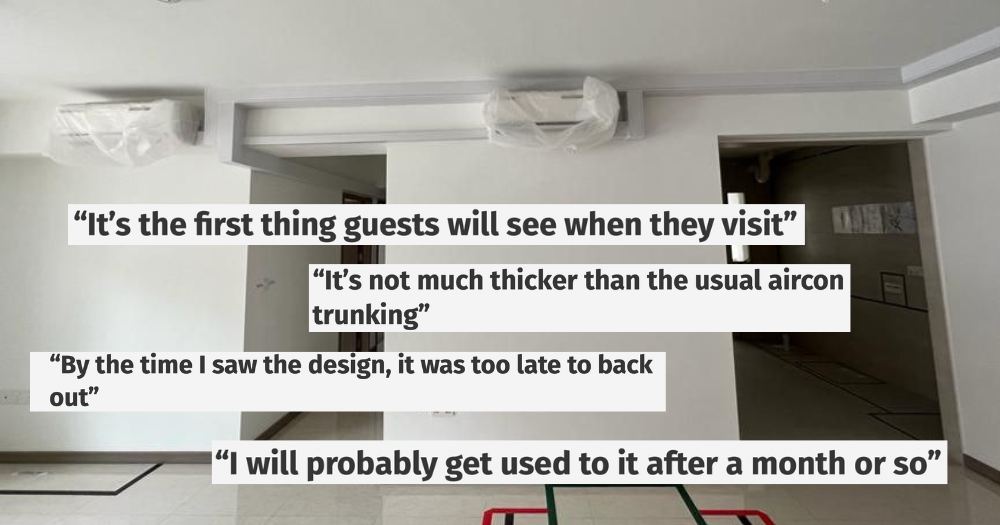"Unsightly".
"No aesthetics at all".
"Omg so ugly! If everyone opt out do u think they will do something about it?"
"Every homeowner has invested a lot of money in home decoration...but this ugly air-conditioning pipes has ruined the dreams of all homeowners."
Such comments were made by members in an unofficial "Tengah BTO" Telegram chat group purportedly set up to help future residents of Tengah, regarding the design of the centralised cooling system that will debut in their homes.
Such negative sentiments are however not shared by all residents and would-be residents of Tengah, the new town that prides itself for sustainable features and smart-technologies.
Six residents that Mothership spoke to said they were satisfied with the design of the aircon system, and some felt the recent criticisms were coming from a vocal minority.
For these interviewees who opted to install the centralised cooling system, a big draw for them is the system's attractive energy savings and environmentally sustainable model.
Centralised cooling system in Tengah HDB units
If you're hearing about this centralised cooling system for the first time, homeowners at Tengah can sign up as early as 2020 for this system, which bears similarities to the system that cools the Marina Bay district.
Instead of each household having an individual compressor, the system operates using central chillers situated on rooftops, which pipe chilled water into homes.
This would yield up to 20 per cent of life cycle savings compared to conventional aircon systems and up to 30 per cent of energy costs, HDB said.
Residents who subscribed to the centralised cooling system can also monitor and control their usage via an app.
SP Group, which runs the system in Tengah, has partnered Daikin on this project, with Daikin installing the aircon units, along with the piping and trunking, in the individual homes.
Homeowners who signed up in advance would have also enjoyed a discounted rate of about 20 per cent, compared to others who signed up after collecting their keys.
What made some residents think twice about subscribing to the centralised cooling system is the trunking.
Leaked pictures of the trunking taken in unfinished flats were circulated as early as July 2022, and this drew the ire of a number of would-be residents.
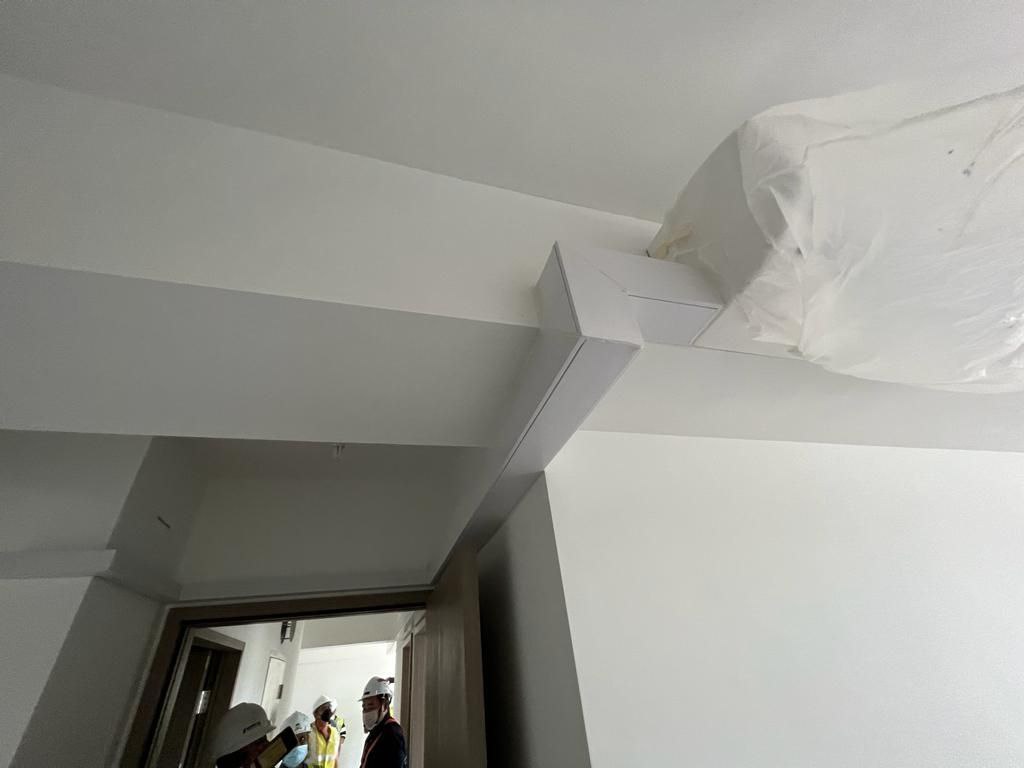 Image courtesy of Micah.
Image courtesy of Micah.
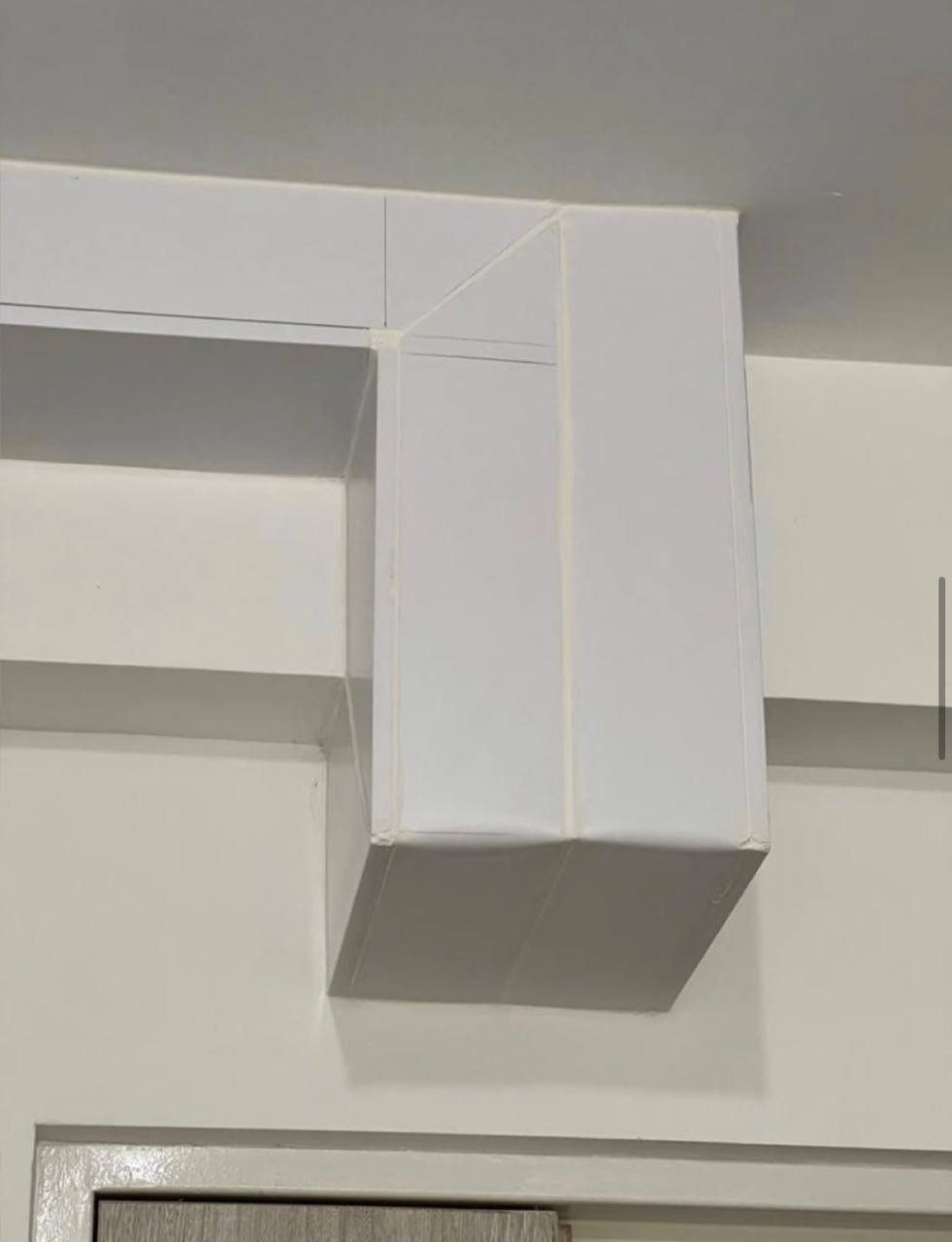 Image courtesy of Micah.
Image courtesy of Micah.
Many complaints centred around the thickness of the trunking, and the unsightly way it snaked from the front door into the living room, even skirting around ceiling beams and pipes.
'Not what I signed up for'
Lai, who is moving into her Tengah home with her fiancé next year, told Mothership, "It just won't look very nice to have it running through the living room...because that's where you have guests, and first impressions are made there."
"But with any new technology, somebody has to be the guinea pig," she added.
Micah, a 28-year-old Tengah homeowner who works as a videographer, opined that the way the trunking was run along the wall was not aesthetically pleasing at all, and that the gap between the pipe and the ceiling would collect dust.
Having signed up for centralised cooling system in 2020, he felt let down, saying that the sales representative had told him the design was "like regular aircon" but the information he was provided was not accurate at all.
He said that the first model available for would-be residents to visualise the system was on the MyTengah app, which made the trunking look more "seamless" than it actually was:
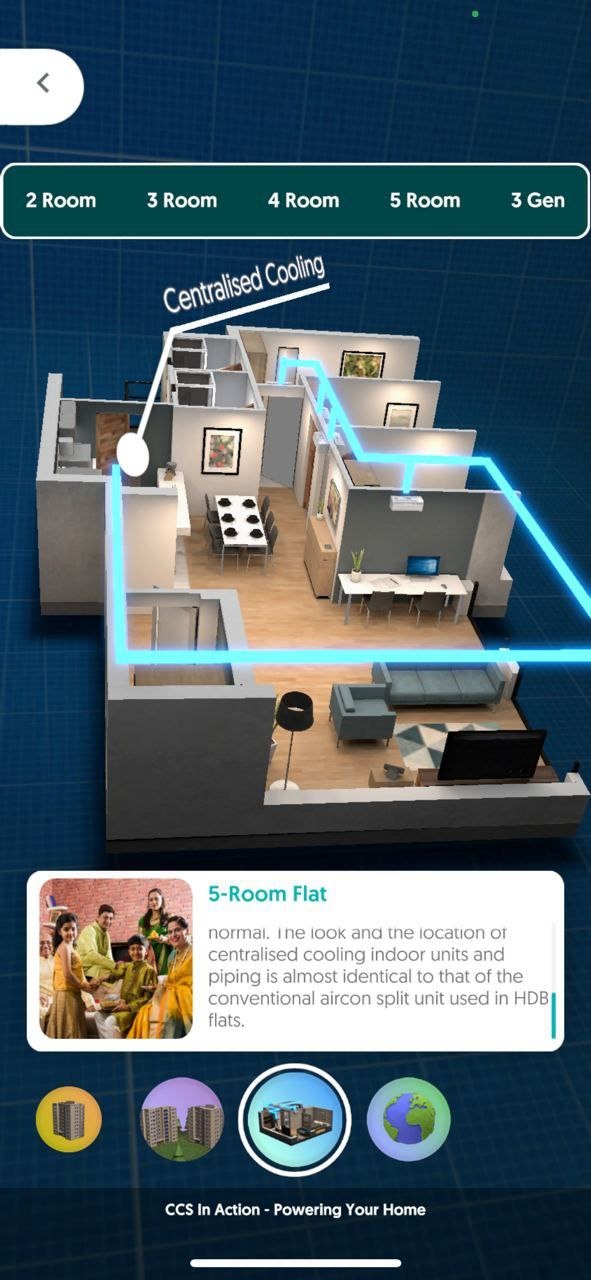 Screenshot from MyTengah app, provided by Micah.
Screenshot from MyTengah app, provided by Micah.
A sample showcasing the centralised cooling system set-up at the HDB Hub's MyTengah Experience Centre is also shown to residents before they sign up for the package.
However, Micah asserted that the limited scale of the set-up, was not "representative" of how the trunking would look in the house.
Here's how the set-up looks like:
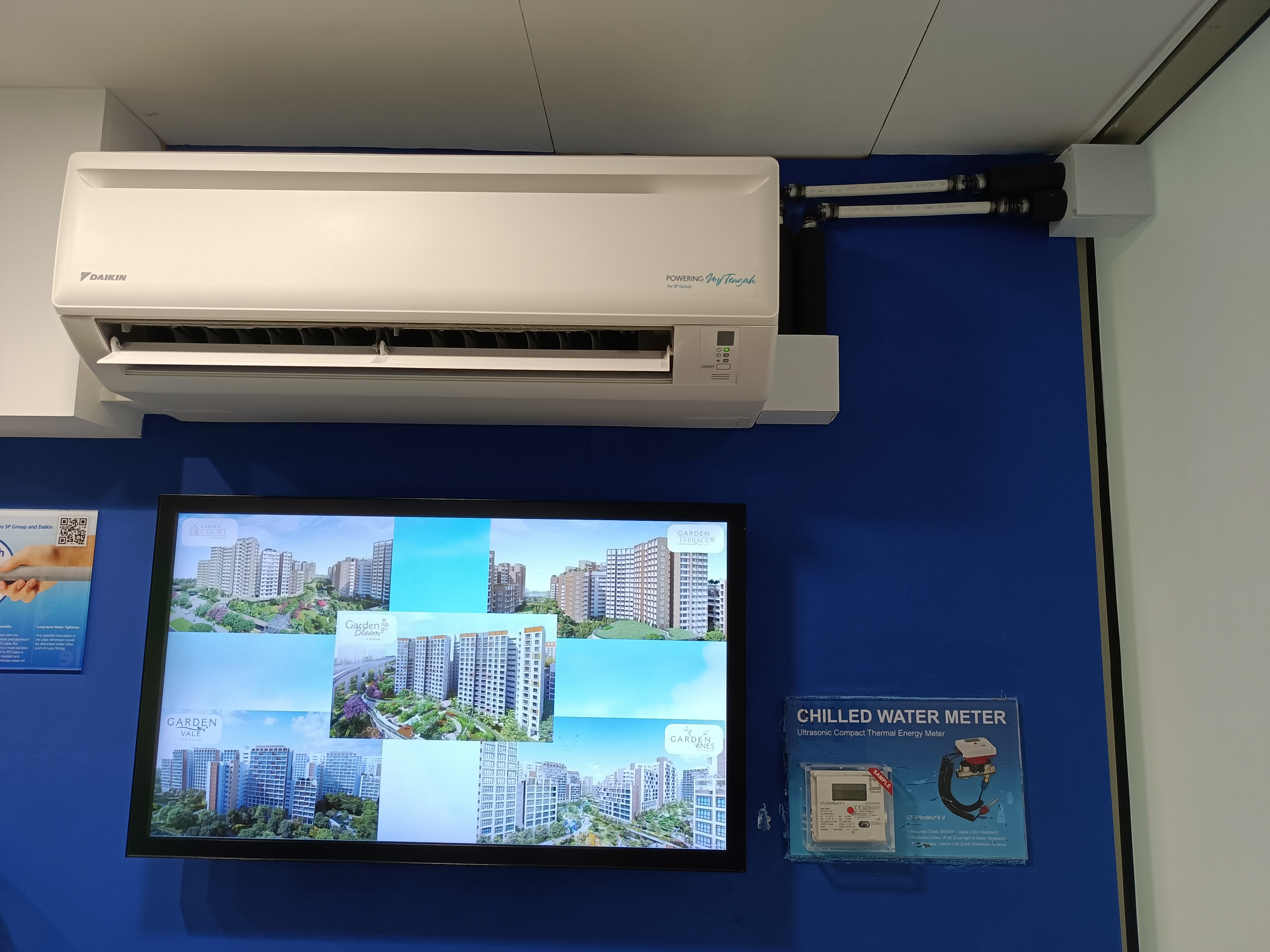 The aircon unit, with a cross section of the pipes and insulation that run inside the trunking. Photo by Daniel Seow.
The aircon unit, with a cross section of the pipes and insulation that run inside the trunking. Photo by Daniel Seow.
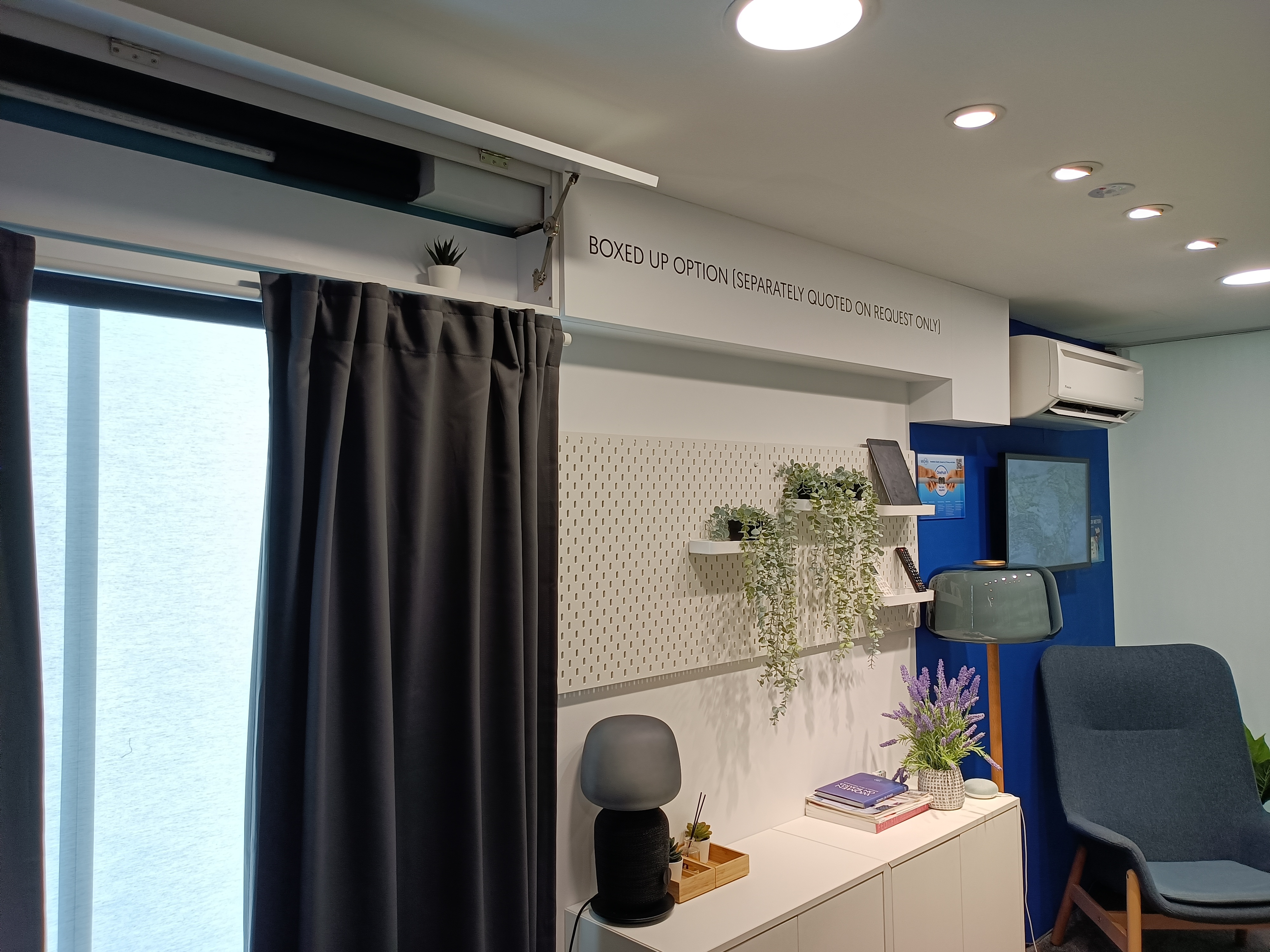 If residents want to box up their trunking to make it more seamless, here's a sample of what it looks like. Photo by Daniel Seow.
If residents want to box up their trunking to make it more seamless, here's a sample of what it looks like. Photo by Daniel Seow.
Only later, he said, there were more accurate 3-D renders of the system provided by interior designers, but by then it was "too late" to back out.
There is a cooling-off period of one month for cancellations, after which homeowners would incur a cancellation fee of 35 per cent.
For a package worth S$3,800, for instance, the cancellation fee would amount to S$1,330, no small sum.
"My main gripe is about the mismanaged expectations," Micah shared, admitting that he had signed the contract with a more "trusting" mentality.
"If I had a better understanding of how different it looks from conventional aircon, then I could have made a better decision."
Views from residents who are ok with the trunking
That said, there are homeowners who are fine with how the trunking looks.
Bryan (not his real name), a 32-year-old resident, shared that the trunking design was a minor issue and he would probably get accustomed it after a month or so.
He opined that the initial pictures of the trunking were particularly shocking because it was shown without comparisons to conventional aircon designs.
Also, he said, these were shown in an unfurnished flat with nothing to distract one's eyes from the trunking.
Other interviewees said that the functionality of the aircon system, and whether it translated into energy savings, was more important to them.
39-year-old Tim (not his real name), who expects to move in to Tengah around mid-2024, also shared that aesthetics would not be the most important concern for him.
"If you're gonna stay in a house for 20 plus years, I think that your focus won't be 100% on the piping," he said.
He also pointed out that residents could try out the centralised cooling system for a few years, and if they were still unhappy with the product, then arrange for a conventional aircon system to be installed instead.
The HDB units at Tengah come with the standard built-in aircon ledges for residents who prefer to install conventional aircon systems.
Willing to try the new technology
Most of the residents Mothership spoke to signed up for their aircon packages as they were confident about the technology used, and found the energy cost savings attractive.
Rachel, a 25-year-old software developer, shared that she was willing to give the technology, which is being pioneered in a residential estate, a shot.
While she is aware of disgruntled residents, she noted that the same few people, not more than 20 in total, were the ones bringing up the topic periodically in the Telegram chat.
The residents she knew more closely though, were more "understanding" of the situation and had gone down to fairs to hear about the options available for them.
Jane (not her real name), a 28-year-old homeowner, added that she and her partner did their own research on the system, before speaking to SP representatives.
She said that earlier on in the project, some of the information shared about the centralised cooling system, including the design of the system and the billing process, was unclear, although this has improved through SP's recent engagements.
"I'm not 100 per confident now, but enough to go ahead with it," she said.
Environmentally friendly option
Other homeowners mentioned that they were motivated to sign up because the system is more environmentally friendly.
Notably, the system produces much less waste heat than what is generated through conventional aircon systems, where condensers are stacked in a vertical configuration at the side of the building.
Lai, who had second thoughts after seeing the design of the trunking, is nevertheless continuing with the centralised cooling system package because she felt it's environmentally friendly.
"I do think we have an interest and a responsibility to do what we can to protect the environment," she said.
James, a 60-year-old semi-retired homeowner, also said,"I'm very proud to tell them that I can live in a green town like Tengah."
Why the trunking is thicker than usual aircon system
Cynthia Wong, SP Group's vice-president of sustainable energy solutions, explained that the trunking includes an extra layer of insulation to maintain the temperature of the chilled water.
This makes the system more efficient and prevents condensation on pipes that could lead to mould damage, she said.
Consequently, it will be 2.5cm thicker than conventional aircon trunking. The trunking at the front door will also be wider, about 25cm to 30cm, since it contains the main pipe supplying the flat.
The trunking will also be painted the same colour as the walls.
Wong added that they have adopted the most optimal design using the least amount of trunking, where pipes run from the main door to facilitate a large volume of water flow from the chiller to the aircon units.
She also acknowledged that since Tengah is the first time centralised cooling system is being piloted in residential estates, there is "room for improvement" in terms of the aesthetics of the design and the materials used.
Cancellations
In June, an anonymous poll was conducted in the above mentioned Telegram group, with 6,859 members in total.
Results indicated that 11 per cent of the 439 voters intended to cancel their subscription due to the "ugly" trunking.
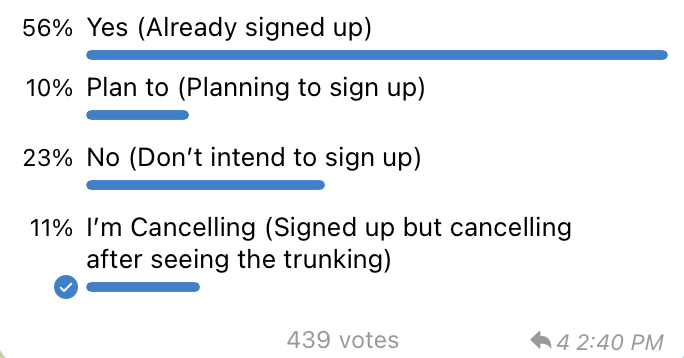
Wong noted that out of the some 10,400 households who have signed up for the centralised cooling system, only 0.5 per cent of them have cancelled their subscriptions. This excludes cases where BTO applicants have cancelled their flat purchase.
She said the main reason given for cancellation was that homeowners had other renovation plans, while a few, mostly seniors, decided they did not need air-conditioning in their unit.
However, some users in the group shared their gripes that cancellation fees are incurred after the 30-day cooling period, regardless of whether the aircon units had been installed in their flats yet.
Others suggested that cancellation fees could be waived or lowered for Tengah residents, given that it was a pilot project.
Wong explained that these fees were to account for the fact that orders will have been placed for materials after the signing of contracts, and in some cases, the pre-installation process would have started.
She did not comment on whether the cooling-off period for cancellations could be lengthened in the future.
Box-up solutions
SP has since shared official photos of the system with residents during ‘re-engagement’ sessions, where they also provided updated information about the centralised cooling system.
Residents can sign-up for box-up solutions offered by interior designers, some of whom are partnering SP Group and providing discounts on the packages.
 Mock-up of a 5-room flat with centralised cooling system installed, along with a box-up solution for comparison. Image from SP Group.
Mock-up of a 5-room flat with centralised cooling system installed, along with a box-up solution for comparison. Image from SP Group.
However, a few of the residents Mothership spoke to shared that they were on the fence about such box-up solutions, since any maintenance would require them to unbox the trunking.
Instead, they would rather "wait and see" how the unit looks before committing to any such renovation.
Joe, 47, who previously worked as an aircon technician for five years, added that concealing aircon pipes could make it harder to detect issues such as leaks which might cost owners more money if maintenance needs to be done.
He also approves of the added insulation the trunking provides, as he had faced issues with the aircon pipes in his current home sweating and growing mold.
Other aesthetic solutions, such as concealing pipes in walls, are not available due to HDB regulations.
Why pipes are not allowed to be concealed in the walls
In response to Mothership's queries, a spokesperson from HDB said that the implementation of the centralised cooling system is one of the key initiatives to develop Tengah as Singapore's first and largest smart and sustainable town.
HDB and its building consultants also work closely with SP Group in determining the optimum functional routing of the centralised cooling system's trunking for the block and within the flat.
During the construction process, HDB does not make provision to conceal pipes or trunking in the flats, as such concealment will make it difficult for residents to adjust the routing and positioning of aircon units, or conduct maintenance, without hacking the wall.
Any unauthorised hacking may also affect the structural integrity of the flat.
HDB is aware that SP Group has received feedback from several homebuyers of the Tengah BTO projects about the positioning of the aircon units and the way the trunking runs through the flats, and that SP Group has reached out to these residents to address their concerns.
Additionally, HDB will continue to work with SP Group to monitor the feedback on centralised cooling system, and will study the feasibility of extending the system to other new BTO developments.
Top image from Tengah BTO Telegram group.
If you like what you read, follow us on Facebook, Instagram, Twitter and Telegram to get the latest updates.

